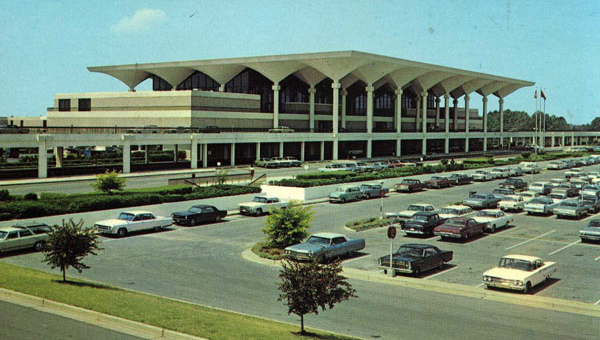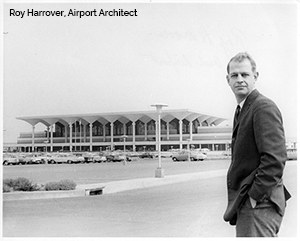 Memphis started its fledgling aviation industry in 1927 when city Mayor Watkins Overton created a municipal Airport Planning Commission. Among the commission’s first tasks was to choose a site for the proposed airport. The commission chose Ward Farm, a 200-acre tract seven miles from Downtown, where the open countryside would allow for future growth.
Memphis started its fledgling aviation industry in 1927 when city Mayor Watkins Overton created a municipal Airport Planning Commission. Among the commission’s first tasks was to choose a site for the proposed airport. The commission chose Ward Farm, a 200-acre tract seven miles from Downtown, where the open countryside would allow for future growth.
The Memphis Municipal Airport, consisting of three hangars and a sod field runway, was dedicated on June 14, 1929. By the following year, the airport had its first lighted runway and as many as 15 passengers a day were arriving and departing Memphis Municipal Airport via American Airways and Chicago & Southern Airlines, the two major carriers serving the airport.
A modern terminal was built in 1938 to meet the demands for increased commercial passenger service. When the United States entered World War II, the U.S. Army assumed control of the Memphis International Airport facilities, halting further expansion and progress until 1947, when the troops vacated the airfield and existing facilities were enlarged.

A new Airport Planning Commission was named in 1956 and members wanted to design and build a new airport terminal to meet the rising demands of the “Jet Age.” The new $5.5 million terminal was dedicated in 1963 and Memphis Municipal Airport was renamed Memphis Metropolitan Airport. The new terminal featured 22 gate positions, allowing enough space for seven airlines to operate daily flights.
The airport’s name was changed in 1969 to Memphis International Airport to reflect its status as a point of origin and entry point for international passengers and cargo. That same year the Memphis-Shelby County Airport Authority was created to plan and direct the future of Memphis aviation. Under the newly created authority, airport terminal capacity would more than double over the next 10 years, with the addition of two sub-terminals and their adjacent concourses.

Memphis International Airport received another huge boost in 1973, when what is now known as FedEx was founded in Memphis, and the company built a sorting facility and an administration building on the airfield. FedEx’s package-sorting complex, which would later come to be known as the World Hub, along with the company’s around-the-clock operations have combined over the years to make Memphis International Airport the busiest cargo airport in the world from 1992 to 2009. Memphis remains one of the busiest cargo airports in the world.
In 1985, Republic Airlines chose Memphis International Airport as one of its hubs, dramatically boosting commercial passenger service. In 1986, Republic merged with Northwest Airlines, setting into motion a flurry of construction projects as the airport sought to keep up with the resulting increase in traffic and service. Construction projects included expanding baggage handling facilities, relocating existing and building new car rental centers, updating food and beverage facilities, repaving runways and aircraft aprons, constructing a new airfield maintenance complex, adding more employee parking areas, enlarging passenger waiting areas, and building a ramp control tower to better manage aircraft parking.
Also in 1986, the authority completed work on a new master plan for continued development, the key elements of which included building a third parallel north-south runway; extending an existing runway to 11,100 feet to better accommodate nonstop international flights; improving existing terminal concourses; building a new International Arrivals Facility; creating additional parking; and making roadway improvements.
As outlined in the 1986 master plan, the new International Arrivals Facility opened in June 1995 to accommodate the first nonstop Northwest/KLM Royal Dutch Airlines Memphis-to-Amsterdam flight, and the third parallel north-south runway became operational in 1996. An 11,100-foot World Runway was dedicated in 2000. The highly anticipated World Runway allows airport access to fully loaded, wide-bodied jets that carry up to 25 percent greater maximum payloads and fly nonstop to points halfway around the globe.
Perhaps one of the most significant occurrences in the history of Memphis International Airport occurred in September 2004 when the Airport Authority negotiated the historic land swap between the Tennessee Air National Guard (TANG) and FedEx. The land swap provided TANG the space it needed to construct new facilities to accommodate the significantly larger C-5 Galaxy aircraft that the Guard were flying as part of its new mission. TANG’s relocation to the southeast corner of the airport freed space for FedEx to expand and consolidate its operations on the north end of the airport. TANG dedicated its new facilities in September 2008.
In June 2013, Delta Air Lines announced that it would no longer maintain hub operations in Memphis, and MEM began the transition to becoming an origin and destination airport. MEM is now focused on passengers who are coming to and from Memphis rather than transferring through Memphis on their way to another destination.
Part of this transition involved recruiting new airlines to serve Memphis. In November 2013, Southwest Airlines began operations at MEM. In March 2014, Frontier Airlines arrived in Memphis. Allegiant Air began operations at MEM in May 2015. Spirit Airlines began operations at MEM in April 2022. Breeze Airways will begin service at MEM in May 2025. In addition to new airlines, all other existing carriers have increased flights since the removal of the Delta hub. MEM remains relentless in its pursuit of frequent and affordable air service.
In February 2022, MEM opened the modernized concourse. All passenger and plane traffic was moved to the remodeled concourse B, which features floor-to-ceiling windows, open air spaces, new retail and concessions and more. Concourses A and C were closed for future development.
In 2024, MEM began phase two of modernization, formally referred to as the Terminal Modernization and Seismic Program (TMSP). This project will bring the terminal building up to current seismic codes and update the facility for future growth and development at MEM.
